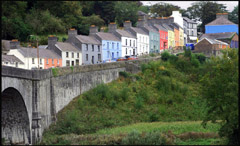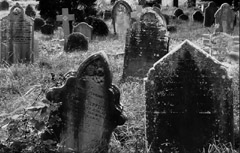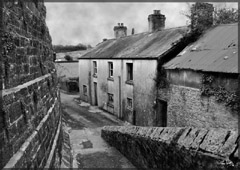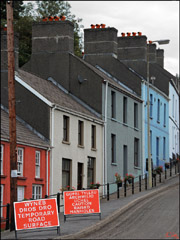Llandeilo is a town in Carmarthenshire, west Wales, situated at the crossing of the River Tywi by the A40 on an elegant stone bridge.
Llandeilo is named after one of the better known Celtic saints of the sixth century, Saint Teilo. The Welsh word "llan" signified a religious enclosure, normally one dedicated to a particular saint (thus corresponds, today, to "church of"). Saint Teilo, who was a contemporary of Saint David the patron Saint of Wales, established a small monastic settlement or "clas" on the site of the present-day church.
The early history of Llandeilo is therefore closely related to the establishment of Christianity in the local area. Although there is very little factual detail about the life of Saint Teilo, the fact that he was highly respected in his lifetime and revered after his death is shown by the forty-five places dedicated to him, some as far afield as Brittany.
After St Teilo's death, two larger ecclesiastical centres in Wales, namely Llandaff Cathedral and St David's Cathedral, laid claim to his body. There is reasonable evidence to suggest however, that Saint Teilo was buried in Llandeilo, where "he spent a solitary life gloriously". The parish church of Llandeilo Fawr (which means Great Llandeilo) is dedicated to Saint Teilo, and until 1880 its churchyard encompassed his baptistry.
The early Christian settlement that developed around the Church of Saint Teilo prospered and by the early ninth century it had attained considerable ecclesiastical status as the seat of a Bishop-Abbot. The Church of Saint Teilo soon became a "mother church" to the surrounding district, acquiring an extensive estate and possessing one of the principality's most beautiful and finely illustrated manuscripts - the Gospel Book of Saint Teilo. The discovery of fragments of two large Celtic crosses from this period provide further testimony to Llandeilo's importance and indeed prestige as an early ecclesiastical centre.
Towards the end of the ninth century, the importance of Llandeilo as a spiritual centre had started to decline and the Gospel Book of Saint Teilo was removed to Lichfield where it became commonly known as the Lichfield Gospels and Book of St Chad. The Bishops of Lichfield still use this manuscript to swear allegiance to the Crown.
In the centuries that followed the Norman Conquest, the Bishops of Llandaff and St David's both claimed Llandeilo for their respective diocese. By the early 12th Century Llandeilo came under the patronage of the Bishopric of St David's, an ecclesiastic borough which became responsible for the affairs of the town including its development as an important market centre to an extensive agricultural hinterland. Until the middle of the last century, a fair called St Teilo's Fair which had been authorised by Edward I in 1290 was held annually in the churchyard. Some of the agricultural produce and other goods offered for sale are recorded to have been displayed on the tombstones.
In the great storm of 1987, the floods were so severe that the River Tywi overwhelmed the railway bridge crossing the river at Llandeilo. A school boy was tragically drowned when a train tried to cross the bridge and the bridge collapsed dropping the train into the raging river. |











